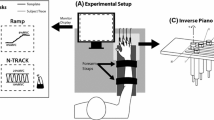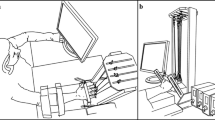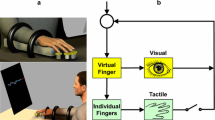Abstract
The purpose of the study was to develop a model of force variability for a fast action performed by a multi-effector system and to verify it for multi-finger quick force production. The experiments involved quick isometric contractions to different target force levels using different finger combinations. Force variance calculated over sets of trials for a multi-finger force production task showed non-monotonic single-peak profiles of force variance with a peak at a time between the times of the maxima of the force rate and of the total force. When analyzed in the four-dimensional space of finger forces, the variance peak was mostly expressed in the direction of the force rate, and was absent in the directions orthogonal to it. The non-monotonic time profile of the force variance could be reproduced by a model of force production, which assumes that each finger force profile is based on a template function scaled in duration and magnitude with two parameters assigned prior to each trial with some variability. The model allows decomposition of the force variance into two fractions related to variability in setting the magnitude and duration scaling parameters. The former fraction changes monotonically with time, while the latter shows a transient peak in the middle of the action. The model was able to reproduce experimental variance time profiles across conditions with the total error of under 8%. The results demonstrate, in particular, that fast multi-finger actions may show transient changes in motor variability in certain directions of the finger force space, particularly in the direction of the first force derivative, without any task-specific coordinating action by the controller. These findings require a reconsideration of some of the conclusions drawn in recent studies on the structure of motor variability in redundant multi-effector systems.






Similar content being viewed by others
References
Danion F, Schöner G, Latash ML, Li S, Scholz JP, Zatsiorsky VM (2003) A force mode hypothesis for finger interaction during multi-finger force production tasks. Biol Cybern 88:91–98
Darling WG, Cooke JD (1987) A linked muscular activation model for movement generation and control. J Mot Behav 19:333–354
Gutman SR, Gottlieb GL (1992) Basic functions of variability of simple pre-planned movements. Biol Cybern 68:63–73
Gutman SR, Latash ML, Gottlieb GL, Almeida GL (1993) Kinematic description of variability of fast movements: analytical and experimental approaches. Biol Cybern 69:485–492
Gordon J, Ghilardi MF, Ghez C (1994) Accuracy of planar reaching movements. I. Independence of direction and extent variability. Exp Brain Res 99:97–111
Jaric S, Gottlieb GL, Latash ML, Corcos DM (1998) Changes in the symmetry of rapid movements: effects of velocity and viscosity. Exp Brain Res 120:52–60
Jones KE, Hamilton AF, Wolpert DM (2002) Sources of signal-dependent noise during isometric force production. J Neurophysiol 88:1533–1544
Khan MA, Lawrence GP, Franks IM, Elliott D (2003) The utilization of visual feedback in the control of movement direction: evidence from a video aiming task. Motor Control 7:290–303
Latash ML, Gutman SR (1993) Variability of fast single-joint movements and the equilibrium-point hypothesis. In: Newell KM, Corcos DM (eds) Variability in motor control. Human Kinetics, Urbana, IL, pp 157–182
Latash ML, Scholz JF, Danion F, Schöner G (2001) Structure of motor variability in marginally redundant multi-finger force production tasks. Exp Brain Res 141:153–165
Latash ML, Scholz JP, Schöner G (2002a) Motor control strategies revealed in the structure of motor variability. Exer Sport Sci Rev 30:26–31
Latash ML, Scholz JF, Danion F, Schöner G (2002b) Finger coordination during discrete and oscillatory force production tasks. Exp Brain Res 146:412–432
Latash ML, Danion F, Scholz JF, Schöner G (2003) Coordination of multi-element motor systems based on motor abundance. In: Latash ML, Levin MF (eds) Progress in motor control, vol.3. Effects of age, disorder, and rehabilitation. Human Kinetics, Urbana, IL, p. 97–124
Li ZM, Latash ML, Zatsiorsky VM (1998) Force sharing among fingers as a model of the redundancy problem. Exp Brain Res 119:276–286
Messier J, Kalaska JF (1999) Comparison of variability of initial kinematics and endpoints of reaching movements. Exp Brain Res 125:139–152
Newell KM (1991) Motor skill acquisition. Ann Rev Psychol 42:213–237
Newell KM, Carlton LG, Hancock PA (1984) Kinetic analysis of response variability. Psychol Bull 96:133–151
Newell KM, Carlton LG (1988) Force variability in isometric responses. J Exp Psychol Hum Percept Perform 14:37–44
Plamondon R, Alimi AM (1997) Speed/accuracy trade-offs in target-directed movements. Behav Brain Sci 20:279–303
Rabin E, Gordon AM (2004) Tactile feedback contributes to consistency of finger movements during typing. Exp Brain Res 155:362–369
Scholz JP, Schöner G (1999) The uncontrolled manifold concept: Identifying control variables for a functional task. Exp Brain Res 126, 289–306
Scholz JP, Danion F, Latash ML, Schöner G (2002) Understanding finger coordination through analysis of the structure of force variability. Biol Cybern 86:29–39
Scholz JP, Kang N, Patterson D, Latash ML (2003) Uncontrolled manifold analysis of single trials during multi-finger force production by persons with and without Down syndrome. Exp Brain Res 153:45–58
Schöner G (1995) Recent developments and problems in human movement science and their conceptual implications. Ecol Psychol 8:291–314
Shim JK, Latash ML, Zatsiorsky VM (2003) The central nervous system needs time to organize task-specific covariation of finger forces. Neurosci Lett 353:72–74
Shinohara M, Scholz JP, Zatsiorsky VM, Latash ML (2004) Finger interaction during accurate multi-finger force production tasks in young and elderly persons. Exp Brain Res 156:282–292
Slifkin AB, Newell KM (2000) Variability and noise in continuous force production. J Mot Behav 32:141–150
Van Beers RJ, Haggard P, Wolpert DM (2004) The role of execution noise in movement variability. J Neurophysiol 91:1050–1063
Van der Meulen JHP, Gooskens RHJM, Denier van der Gon JJ, Gielen CCAM, Wilhelm K (1990) Mechanisms underlying accuracy in fast goal-directed arm movements in man. J Motor Behav 22:67–84
Zatsiorsky VM, Li ZM, Latash ML (1998) Coordinated force production in multi-finger tasks: finger interaction and neural network modeling. Biol Cybern 79:139–150
Zatsiorsky VM, Latash ML (2004) Prehension synergies. Exer Sport Sci Rev 32:75–80
Acknowledgments
Preparation of this paper was supported in part by NIH grants AG-018751, NS-35032, AR-048563, and M01 RR10732.
Author information
Authors and Affiliations
Corresponding author
Appendices
Appendices
Appendix A. Model of parametric force control
The equation of parametrical multi-finger force control is f kn (t)=g(b kn ,u n , t,τ kn )=b kn u n (t/τ kn ) where f kn (t) is the actual force time profile of the finger n∈{I,M,R,L} in the kth trial, u n (t) is a template, and b kn and τ kn are scaling parameters. For small changes of the scaling parameters
where Δf n (t), Δb n , and Δτ n are increments of the force and its scaling parameters, \( \frac{{\partial g_{n} (t)}} {{\partial b_{n} }} \) and \( \frac{{\partial g_{n} (t)}} {{\partial \tau _{n} }} \) are partial derivatives of the force with respect to the parameters. The two summands of the force increment are:
(because f′ n (t)=\( \frac{1} {{\tau _{n} }} \) b n u′ n (t/τ n )). So, Eq. (11) can be written:
(see also Gutman and Gottlieb 1992).
Appendix B. Two components of the model force variance
Assume that changes in the finger force time profile are defined by the variability of scaling parameters b kn and τ kn , which are random variables with means \( \overline{b} _{n} \) and \( \bar{\tau }_{n} \) and variances Var(b n ) and Var(τ n ) (or standard deviations SD(b n ) and SD(τ n )). Assume also that SD(b n )<<\( \overline{b} _{n} \) and SD(τ n ))<<\( \bar{\tau }_{n} \); covariances Cov(b n ,b m )≠0, Cov(τ n ,τ m )≠0, Cov(b n ,b m )=0; and templates u n (t) are deterministic functions. The covariance between forces of fingers n and m at a time t can be estimated as:
Here and further, \( \overline{{( * )}} \) is the sign of mean. Substituting the expression of \( \overline{{\Delta f_{n} (t)\Delta f_{m} (t)}} \) via increments of the scaling parameters (Eq. 12) yields:
where r is coefficient of correlation. According to Eq. (14), force covariance is the weighted sum of two functions, \( \overline{{f_{n} {\text{(}}t{\text{)}}f_{m} {\text{(}}t{\text{)}}}} \) and \( t^{2} \overline{{{f}'_{n} {\text{(}}t{\text{)}}{f}'_{m} {\text{(}}t{\text{)}}}} \), with weights x nm =\( \frac{{{\text{SD}}(b_{n} )}} {{\bar{b}_{n} }}\frac{{{\text{SD}}(b_{m} )}} {{\bar{b}_{m} }}r(b_{n} ,b_{m} ) \) and y nm =\( \frac{{{\text{SD}}(\tau _{n} )}} {{\bar{\tau }_{n} }}\frac{{{\text{SD}}(\tau _{m} )}} {{\bar{\tau }_{m} }}r(\tau _{n} ,\tau _{m} ) \). Using CV for coefficient of variation, one gets:
If force variability is small, approximately \( \overline{{f_{n} {\text{(}}t{\text{)}}f_{m} {\text{(}}t{\text{)}}}} \)=\( \overline{{f_{n} {\text{(}}t{\text{)}}}} {\kern 1pt} \,\overline{{f_{m} {\text{(}}t{\text{)}}}} \); assuming that force rate variability is also small, the scalar expressions for all n and m can be written as a matrix equation:
where \( {\bf{D}}(\overline{{{\bf{f}}(t)}} ) \) and \( {\bf{D}}(\overline{{{\bf{{f}'}}(t)}} ) \) are diagonal matrices, in which diagonal entries are mean force {\( \overline{{f_{n} {\text{(}}t{\text{)}}}} \)} and force rate {\( \overline{{{f}'_{n} {\text{(}}t{\text{)}}}} \)} time profiles, and {x mn } and {y mn } from Eq. (15) are entries of the matrices X and Y. Thus, the covariance matrix consists of two terms, related to setting the magnitude and duration scaling parameters, respectively.
Appendix C. Dependence of force variance upon time and direction in force space.
Values of CV(τ) estimated from experimental data differ for different fingers. However, for simplicity, consider a common timing scaling parameter for all fingers with CV(τ n )=ξ τ for all n, and r(τ n , τ m )=1 for all n and m. In this case, Y ss=ξ τ E, where E is a matrix with unit entries.
The expression for force variance in the direction of a vector w via Rayleigh fraction with a covariance matrix Cov(f(t)) is:
Here, we assume w a vector with unit norm. Let v be orthogonal to the direction of the force rate vector \( \overline{{{\mathbf{{f}'}}(t)}} \). The second term of the right side of Eq. (17), Var τ (t) is:
The factor \( {\bf{D}}(\overline{{{\bf{{f}'}}(t)}} ){\bf{v}} \) is a vector:
\( {\mathbf{D}}(\overline{{{\mathbf{{f}'}}(t)}} ){\mathbf{v}} \) multiplied by E is a zero vector, because each of its components
is a scalar product of orthogonal vectors \( \overline{{{\mathbf{{f}'}}_{{}} (t)}} \) and v(t). Therefore, Var τ (t) is zero. This means, that variance time profile in directions orthogonal to the direction of the force rate vector is defined only by the other term of Eq. (17). In our case, this term is monotonic, and hence the force variance time profile is not expected to show transient peaks (such as the V-peak).
Rights and permissions
About this article
Cite this article
Goodman, S.R., Shim, J.K., Zatsiorsky, V.M. et al. Motor variability within a multi-effector system: experimental and analytical studies of multi-finger production of quick force pulses. Exp Brain Res 163, 75–85 (2005). https://doi.org/10.1007/s00221-004-2147-z
Received:
Accepted:
Published:
Issue Date:
DOI: https://doi.org/10.1007/s00221-004-2147-z




